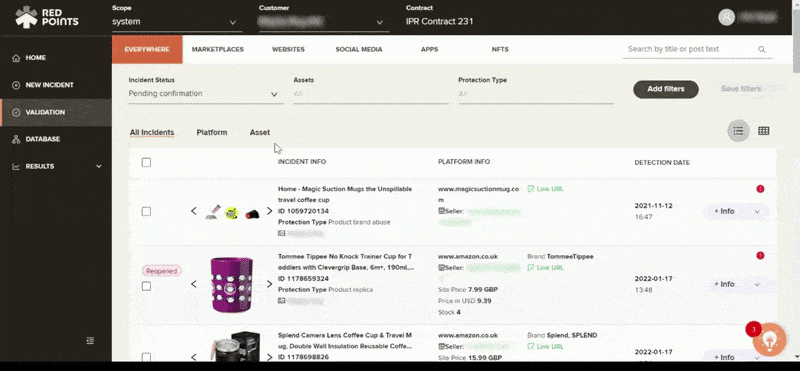Protecting your website from copycats and preventing it from getting spoofed is one of the biggest challenges faced by businesses – both big and small. From damaging your business reputation to tricking your customers, bad actors can have several motives to copy your website. But all of them lead to the same conclusion – scammers stealing your identity and assets, leading to your business losing revenue.
In this article, we discuss:
- What a copycat website is
- How to spot a copycat website
- Website threats to watch out for
- The impact of copycat websites on businesses
- How to protect your website from copycats
- What to do if you find a copycat website of your business
- How you can report copycat websites with automation
What is a copycat website?
Copycat websites are websites that copy the look of an official website to catch out unwary visitors, siphon profits away from real brands and get people to give over sensitive personal information. The intention of these copycats is always to mislead and steal. As a result, these kinds of websites can be very damaging to a brand’s reputation and profits.

How to spot a copycat website?
To avoid falling into the trap, you have to know how to spot a copycat website. Usually, there are indicators at various points of your journey through a fake website.
Firstly, check the domain name closely. If the domain name is different from the official website that’s a sure indicator that something is wrong. Copycats often try to use domain names that are similar to the real version to make it difficult for you to spot something is wrong at first glance.
Often scammers will build these copycat websites quickly and may not pay attention to the details. Sometimes you can spot a copycat website by typos, strange grammar, or awkward design and layout issues. Copycats may also exaggerate elements in a way that an official brand wouldn’t. For example, if there are deals that look too good to be true or a group of overly positive reviews that all sound quite similar, that should set off alarm bells.
Another quick way to spot a possible copycat website is by looking in the URL bar to see whether there is a padlock symbol on the far left. Web browsers like Google Chrome, Firefox, and Safari, all use security certificates (SSLs) as a measure of verification. The padlock symbol is a good sign that any information you give to that site will not be received by external hackers. However, if you want to be sure that you’re not on a copycat website you should always consider the padlock alongside the other indicators we’ve mentioned.
Website threats to watch out for
Spoofing a website is one of the easiest things to do and it doesn’t even require coding or advanced technical knowledge. It is also one of the oldest tricks in the books and the reason scammers continue to use this trick is simply because it works.
The main methods that scammers use for website spoofing include:
Domain name squatting
This method involves registering a domain name that is similar to an existing business name or just registering the same domain name but with a different website extension.
For instance, if your website is registered under brandname.com, the scammers may register brandname.co.au or brandname.co.uk, to fool customers into believing they are on the official website.
In some cases, scammers hold onto the squatted domain name without impersonating the original website, just to sell it back to the business and make quick profits.
Typosquatting
With typosquatting, scammers try to lure in customers who end up mistyping the web address of a business. They register domains that have similar names as some businesses but with a small difference – there is a typo in the domain names.
Sometimes the typo is so small that you may not even notice it, especially when you get directed to a website that looks almost identical to the original website in terms of design and content.
For instance, scammers could register domain names like amxzon.com or amazxn.com just to confuse website users.
URL cloaking
URL cloaking involves using specialized scripts to cover up the actual URL and make web users think they are being led to a trusted website. Scammers can then share these cloaked URLs with unsuspecting Internet users to trick them.
Spoofing is typically done to steal sensitive information. This can be personal data like names, email addresses, and even login credentials. Scammers can also steal the financial information of customers making purchases on the website thinking it’s the original and gain access to credit card details, social security numbers, and bank account numbers.
Apart from this, scammers may also use website spoofing to sell counterfeit copies of products. They copy the business’s website design, content, product listings, and even trademarks to mimic the original website and try to sell counterfeits to unknowing customers.

Impact of copycat websites on businesses
Brand reputation
When unaware customers end up buying a counterfeit, assuming they are buying original products, it can severely affect their experience with your brand. The customers will eventually end up blaming your business for the counterfeits and even write bad reviews online, all of which can severely affect your brand reputation.
Customer trust
When customers who are genuinely interested in your business end up receiving very low-quality products, it can directly affect how they view your products. Customers who have already been tricked into buying counterfeit products can be unlikely to make another purchase with your brand.
Moreover, customers can also share sensitive and personal information on spoofed websites which can lead to them becoming victims of fraud and phishing.
Revenue losses
Every time a counterfeit product is sold, it causes direct sales loss to your business. The problem can get even more complicated as many of the customers purchasing your products may not know that they are buying fake products. Spoofed websites lead to reduced traffic to your business website, decreased revenue, and depleted customer loyalty.
How to protect your website from being copied
Here are a few measures that you can implement on your website to prevent it from being copied.
- Make your copyright notice clear and visible
The first step to help you protect your website from copying is all about copyright notices. A copyright notice will enable you to outline the kind of use you will allow of your site and ward off potential scammers.
Clear and visible copyright notices are highly recommended because as well as deterring infringers they will make it easier to show deliberate copyright infringement. Depending on your content there are a variety of ways you can write your copyright notice. A common copyright notice may look like this: © [Full Name] and [Site Name], [Current Year or Year Range].
You can also add a copyright notice in a footer file like this, <p>© 2018-2023 Redpoints.com</p>. But remember that you need to update it every year!
- Disable the right-click option
If you’re afraid that copycats will visit your website just to right-click, copy all the information off your page, and paste it onto their copycat website, then a simple solution is to disable the right-click option. This will make it difficult for the average copycat to steal and repurpose your content. You can restrict right-click options with various plugins.
While effective, this approach does have some downsides. For example, by disabling right click you may limit the user’s ability to navigate around your website. Also disabling the right-click option does not remove the ability to screenshot the information and copy it out manually. While it makes the process of copying your website content more arduous, it does not make it entirely foolproof.
- Protect your images with watermarks
If you’re specifically worried about copycats stealing your images then you can include watermarks on them. Watermarks are visual reminders that these images were created by you and belong to you. Scammers won’t be able to steal and copy them without displaying the watermark. This watermark will point back to the source of the copied images and hopefully let users know they are on a copycat website.
What to do if you find a copycat website for your business
- Send a cease and desist letter to the site admin as soon as you notice a fake or spoofed website. Inform them that they are infringing on your intellectual property. You can find the information about the site admin or owner through ICANN.
- Notify the domain registrar that a domain they are hosting is selling counterfeit products and infringing on your Intellectual Property (IP). If you choose to file a legal case against the site admin, you can also file a case against the domain hosting provider that continued to give the scammers a platform. As a result, when you notify the domain registrars, they are required to respond to you and take action.
- Report the website to Google to get it de-indexed and removed from search engine results. But it’s important to note that this will not take down the website completely.
How can you report hundreds of copycat websites at once using automation?
If your website is being targeted by multiple copycat websites it can become tiresome and time-consuming to try to combat them all manually. The key to overcoming this problem is automation.
Red Points’ Domain Takedown Service is an automated way to find and remove copycat domains that are taking advantage of your brand and website. Our software scans the surface web to find similar domains, copyrighted images, and trademarks. Then, when we detect a potential copycat, our Domain Takedown Service will report the fake website right away, uncover the scammer’s identity, and leverage data to stop repeat infringers from creating copycats in the future.
Our Domain Takedown Service detects copycats with over 90% accuracy. Here’s how each step of the service functions:
- Monitoring & Detection
Red Points’ automated system monitors the web 24/7, searching for registered domains that may be infringing your copyrighted images or trademarks. Our system is designed for constant automated monitoring and detecting to ensure that you never have to worry about copycats slipping through the cracks.
When we detect a potential copycat you will be able to see a screen capture of their website and a link within the platform so that you can validate if it’s fake. If it is indeed a copycat then we move to enforce.
- Enforcing
Red Points makes enforcing easy with our automated domain takedown service. As well as manually requesting takedowns against specific copycat websites, you can also automate takedown requests to ensure that the whole protection process continues to run in the background. Once you identify the kind of copycat phishing sites you want removed, our service will automatically remove them to make sure your brand is protected.

- Explore the economic impact
Our Domain Takedown Solution keeps providing value even after enforcement is over. After the takedown requests have been sent to the copycats you will be able to explore how much revenue you have recovered. Our performance dashboards provide a clear visual indication of how effective our Domain Takedown Solution has been.
- Receive custom reports
Beyond an economic analysis, our service will also provide you with reports tailored to your business. You can request specific data and access information relevant to your situation. Use these custom reports to learn about the most common infringements and the enforcement success rates.
What’s Next
Automated technology allows you to spend more time on creative and interesting tasks and less time on annoying, dull ones. New copycat websites appear all the time and it can be tough for one individual to stop the flow of copycats from becoming overwhelming.
Automation will help you act in a preventative capacity, stem the flow of scammers, and ensure you spend less money on legal fees in pursuit of elusive copycats. Now you know how to protect your website from being copied, it is time to act.
Over 1,200 clients from industries all over the world use Red Points to protect their websites from copycats and scammers. If you’re ready to join that group and start automating your website protection process, request a demo of Red Points’ Domain Takedown Solution today!






